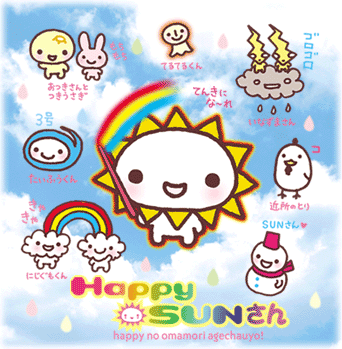Yunomichan Japanese Name: ゆのみちゃん
Literal Translation: Little Teacup¹
Released: February 2002
Original Japanese: WWW  PDF PDF
This heartwarming character makes delicious tea for you. Please pause to take a hot sip from Yunomichan.
おいしいお茶を入れてくれる心あたたまるキャラクター。ゆのみちゃんでホットひといきついてください。
Characters
 |
 |
 |
 | Yunomichan
Little Teacup¹ | Matcha
Green Tea² | Genmaicha
Brown Rice Tea³ | Houjicha
Pan Roasted Tea4 |
 |
 |
 | Sakuramochi
Cherry Blossom Rice Cake5 | Imokintsuba
Potato Fudge6 | Konpeitou
Sugar Candy7 |
 |
 | Jasminechan
Little Jasmine Tea
| Kouchakun
Little Black Tea
|
Images
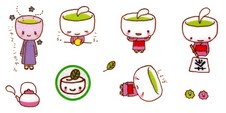  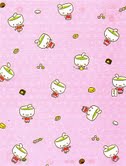 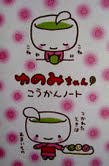  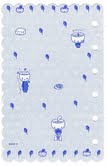 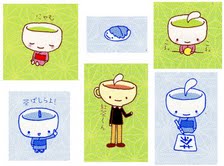
Translation Notes
- Yunomi (湯呑み or ゆのみ, literally: cup for a hot drink) are the handle-less teacups, typically made from a ceramic material, being taller than wide, with a trimmed or turned foot. Unlike the more formal chawan (茶碗) tea bowl which is used during the Japanese tea ceremony, the yunomi is made for daily (or informal) tea drinking. Wikipedia: Yunomi, Wikipedia: Chawan
- Matcha (抹茶) refers to finely-milled green tea. The cultural activity called the Japanese tea ceremony centers on the preparation, serving, and drinking of matcha. In modern times, matcha has also come to be used to flavour and dye foods such as mochi and soba noodles, green tea ice cream and a variety of wagashi (Japanese confectionery). Wikipedia: Matcha
- Genmaicha (玄米茶, "brown rice tea") is the Japanese name for green tea combined with roasted brown rice. It is sometimes referred to colloquially as "popcorn tea" because a few grains of the rice pop during the roasting process and resemble popcorn. This type of tea was originally drunk by poor Japanese, as the rice served as a filler and reduced the price of the tea; which is why it is also known as the "people's tea". Today it is consumed by all segments of society. Tea steeped from these tea leaves has a light yellow hue. Wikipedia: Genmaicha
- Houjicha (ほうじ茶 or 焙じ茶) is set apart from other Japanese green teas because it is roasted in a porcelain pot over charcoal. The tea is fired at high temperature, altering the leaf color tints from green to reddish-brown. Wikipedia: Hojicha
- Sakuramochi (桜餅) is a variety of wagashi, or Japanese confectionery consisting of a sweet pink mochi (rice cake) and red bean paste, covered with a leaf of sakura (cherry blossom). Wikipedia: Sakuramochi
- Imo kintsuba (芋金鍔 or いもきんつば) is a type of kintsuba made of sweet potato. Kintsuba is a traditional Japanese confectionery that consists of anko (sweet bean paste), coated with a thin layer of flour, and typically molded into squares. There are different variations of kintsuba such as imo kintsuba (sweet potato kintsuba) or kuri kintsuba (chestnut kintsuba). Wikipedia: きんつば
- Konpeitou (金平糖, 金米糖, or 金餅糖 or こんぺいとう, コンペイトー) is a Japanese hard candy originally made in Portugal. The word "konpeitou" comes from the Portuguese word confeito, which means a sugar candy. It was introduced to Japan somewhere around the 15th and 16th century by traders from Europe. Wikipedia: Konpeito
|
Japanese Name: 健康ぼうや
Literal Translation: Health Boy
Release Date: February 2002
Original Japanese: WWW  PDF PDF
Protect the bright future of your tummy! Together with Kenkou Bouya, let's try to consider regards for the health of your tummy! Also, meet Senikun¹ and Bifiduschan.²
明るいおなかの未来を守る!健康ぼうやと一緒におなかの健康について考えてみよう!せんい君や、ビフィズスちゃんもよろしくね。
Translation Notes - Seni (食物繊維 or しょくもつせんい, shokumotsu seni) refers to dietary fiber. There are many Japanese drinks to aid in digestion that include seni. Wikipedia: Dietary fiber
- Bifidus (ビフィズス菌) or bifidobacterium is a bacteria that aids in digestion. In Japan, there are bifidus yogurt drinks to aid in digestion. Wikipedia: Bifidus
|
Japanese Name: HAPPY SUNさん
Literal Translation: Mr. HAPPY SUN
Release Date: February 2002
Original Japanese: WWW  PDF PDF
Always smiling with good weather! When there is only SUNsan, everyone all around can become happy. When you have SUNsan with you, you can also become popular?! When there is only SUNsan, everyone all around has lighthearted fun! Therefore, there are always tons of friends at SUNsan's side. When he has a friend who is feeling down, SUNsan uses a teruteru bouzu¹ to cheer them up. Kind and warm, SUNsan is popular with everyone.☆
いつもニコニコいい天気!SUNさんがいるだけで、まわりはみんなhappyになれる。そんなSUNさんグッズをもっているとあなたも人気者になれる?!SUNさんがいるだけで周りのみんなは楽しくウキウキ!だからSUNさんのそばはいつも仲間でいっぱい。落ち込んでいるおともだちには、SUNさんがてるてる坊主をくれて元気づけてくれます。やさしくってあったかい、SUNさんはみんなの人気もの☆
Characters

|

|

|

|

| SUNsan
Mr. SUN
This sun character is always smiles and making everyone happy. When
you feel down, he uses a teruteru bouzu¹ and cheers you up.
いつもニコニコみんなを幸せにしてくれる太陽キャラ。落ち込んでいるとてるてるぼうずをくれて、元気づけてくれるよ。
| Otsukisan to Tsukiusagi
Mr. Moon and Moon Rabbit
When it becomes night, he takes SUNsan's place. The mochi² that Tsukiusagi makes is very delicious!
夕方になるとSUNさんと交代する。つきうさぎのつくもちはとってもおいしい!
| Nijigumokun
Little Rainbow Cloud
These two always love to be in high spirits! They are also close
friends of SUNsan. These two stick together when there is a rainbow.
いつも二人ではしゃぐのが大好き!SUNさんともとっても仲良し。ふたりの仲がいいときは虹がかかっているよ。
| Taifuukun
Little Typhoon
Besides those 3, there are actually many more [in the weather group]; the bigger the number [of group members], the bigger the storm?! If you ride on Taifuukun, you can move super fast.
3号以外にも実はたくさんいて、番号が大きくなればなるほど、実物も大きくなるとか?! たいふうくんに乗るとすごい早さで移動できるんだって。
| Inazumasan
Mr. Bolts of Lightning
Their faces look a little scary but actually there are times when they are nice, too. Apparently, they slightly admire SUNsan.
ちょっとコワイカオをしているけど、実はやさしいところもあるんだよ。 SUNさんにちょっとあこがれているらしい。
|

|

|

|

| Kinjyo no Tori
Neighborhood Bird
This bird lives in SUNsan's neighborhood. Everyday, he wakes up with SUNsan, as SUNsan lets him know it's morning. Because SUNsan can't fly in the sky, he appears by riding the clouds.
SUNさんの近所に住むとり。毎朝SUNさんと一緒に起きて、朝を知らせてくれる。空を飛べないのでくもに乗って登場するよ。
| Kasakun
Little Umbrella
As his special skill is that he can open and expand, he tries to make everyone happy by taking care of them.
とじたりひらいたりできる特技をみんなにみてもらうのがうれしいみたい。
| Teruterukun
Little Teruteru¹
Night after night, SUNsan makes this teruteru bouzu. He is an amazing omamori,³ as if you receive this, you will become very happy.
SUNさんが夜な夜な作るてるてるぼうず。これをもらうととってもハッピーになれる、すごいおまもり。
| Yukidarumasan
Mr. Snowman
He loves SUNsan, and when it's winter, they have a lot of fun. However, they can't get close at all or he will accidentally melt.
SUNさんのことが大好きで冬に会えるのを楽しみにしている。しかし、溶けてしまうのであまり近づけないんだって。
|
Images
 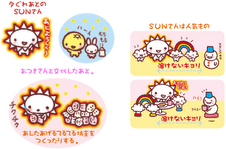 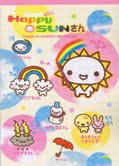 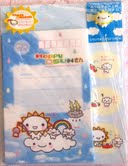 
Translation Notes
- Teru teru bōzu (てるてる坊主), literally meaning "shiny-shiny Buddhist priest," is a little traditional hand-made doll made of white paper or cloth that Japanese farmers began hanging outside of their window by a string. This amulet is supposed to have magical powers to bring good weather and to stop or prevent a rainy day. "Teru" is a Japanese verb which describes sunshine, and a "bōzu" is a Buddhist monk (compare the
word bonze), or in modern slang, "bald-headed." Today, children make teru-teru-bōzu out of tissue paper or cotton and string and hang them from a window to wish for sunny weather, often before a school picnic day. Hanging it upside down - with its head pointing downside - acts like a prayer for rain. They are still a very common sight in Japan. Wikipedia: Teru teru bozu
- Mochi (餅) is a Japanese rice cake made of glutinous rice pounded into paste and molded into shape. In Japan it is traditionally made in a ceremony called mochitsuki. While also eaten year-round, mochi is a traditional food for the Japanese New Year and is commonly sold and eaten during that time. In Japanese tradition, rabbits live on the moon where they make mochi. This comes from interpreting the pattern of dark patches on the moon as a rabbit standing on tiptoes on the left pounding on an usu, a Japanese mortar. A popular culture manifestation of this tradition can be found in the character title character of Sailor Moon, whose name is Tsukino Usagi, a Japanese pun on the words meaning "rabbit of the moon." Wikipedia: Mochi, Wikipedia: Moon Rabbit
- Omamori (お守り) are Japanese amulets dedicated to particular Shinto deities as well as Buddhist figures. The word mamori (守り) means protection, with omamori meaning "honorable protector." Wikipedia: Omamori
|
 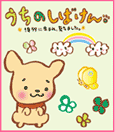
Uchinoshibaken
うちのしばけん  Our Shiba Dog ¹  February 2003  San-X San-X  PDF PDF
He is a purebred born in Hakata. This shiba dog, that depends on other's kindness and tends to become lonely, loves pink Poodlechan.☆ Please watch over this friendly pair.
博多生まれの純粋キャラ。甘えん坊でさびしがりのしばは、ピンクのプードルちゃんがだいすき☆仲良しの二人を見守って下さいね。
Translation Notes
- The Shiba Inu or Shiba Ken (柴犬 (しばいぬ、しばけん)) is the smallest of the six original and distinct breeds of dog from Japan. A small, agile dog that copes very well with mountainous terrain, the Shiba Inu was originally bred for hunting. It is similar in appearance to the Akita, though much smaller in stature. "Inu" means dog and the word shiba means "brushwood" in Japanese, and refers to a type of tree or shrub whose leaves turn red in the fall. Wikipedia: Shiba inu
|
Japanese Name: サルアポー
Literal Translation: Monkey Apple
Release Date: February 2002
Original Japanese: WWW  PDF PDF
In just a short time, there is a cute monkey and friends. Saruapou has many comrades and actually belongs to a professional wrestling organization. Everyday he drips of sweat with his friends that brim with individuality.
ちょっと間のぬけたカワイイおさると仲間たち。たくさん仲間のいるサルアポーは、実はプロレス団体に所属していて、毎日個性あふれる仲間たちと汗を流しているんだよ。
|
Boku Tsucchii Japanese Name: ボクツッチー
Literal Translation: I am tsucchii¹
Release Date: February 2002
Original Japanese: WWW  PDF PDF
He loves mushrooms! Is he a tsuchinoko (?!)¹ He looks like a mysterious character. When you drink nameko² mushroom miso soup³, you remember your mother in the distant countryside. However, it seems that the tsucchii don't like nameko mushrooms...
キノコ大好き!ツチノコ(?!)みたいな不思議なキャラクター。なめこの味噌汁を飲むと、遠い田舎の母を思い出します。ツッチーはなめこが苦手なようですが…。
Characters

|

|

|

|
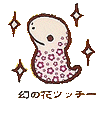
| Yamatsucchii
Mountain Tsucchii¹
Length ... 30 ~ 50 cm (Apparently once in a long while they are bigger than people). Sound it makes ... "kyu kyu." In particular, apparently he loves shimeji4 mushrooms. Apparently he doesn't like nameko² mushrooms. (Because they are slimy and slippery.) Apparently in the winter he goes into a hole and hibernates.
体長・・・30~50cm (ごくまれに人より大きなものもいるらしい)。鳴き声・・・「キュッキュッ」。とくにしめじが好きらしい。なめこはニガテらしい。(ヌルヌルしてるから。)冬は穴に入って冬眠するらしい。
| Kawatsucchii
River Tsucchii¹
Apparently he mainly eats types of mushrooms.
おもにキノコ類を食べるらしい。
| Numatsucchii
Swamp Tsucchii¹
Apparently when she is happy, she jumps up and down 10 meters high. Apparently the females are bigger.
おどろくと十メートルも飛び跳ねるらしい。ツッチーはメスの方が大きいらしい。
| Moritsucchii
Forest Tsucchii¹
Apparently he dangles and sleeps from a tree.
木にぶらさがって眠るらしい。
| Maboroshinohanatsucchii
Phantasmic Flower Tsucchii¹
|
Images
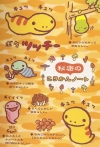 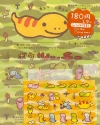
Translation Notes - The Tsuchinoko (ツチノコ or 槌の子) literally translating to "hammerspawn," is a legendary snake-like cryptid from Japan. The name tsuchinoko is prevalent in Western Japan, including Kansai and Shikoku; the creature is known as bachi hebi (バチヘビ) in Northeastern Japan. Tsuchinoko are described as being between 30 and 80 centimeters in length, similar in appearance to a snake, but with a central girth that is much wider than its head or tail, and as having fangs and venom similar to that of a viper. Some accounts also describe the tsuchinoko as being able to jump up to a meter in distance. According to legend, some tsuchinoko have the ability to speak and a propensity for lying, as well as a taste for alcohol. Legend also records that it will sometimes swallow its own tail so that it can roll like a hoop,similar to the mythical Hoop snake. Wikipedia: Tsuchinoko
- Nameko (ナメコ or 滑子, Pholiota nameko) is a small, amber-brown mushroom with a slightly gelatinous coating that is enjoyed in miso soup and nabemono. Wikipedia: Nameko
- Miso soup (味噌汁) is a traditional Japanese soup consisting of a stock called "dashi" into which is mixed softened miso paste. Although the suspension of miso paste into dashi is the only characteristic that actually defines miso soup, many other ingredients are added depending on regional and seasonal recipes, and personal preference, such as mushrooms, seaweed, and scallions. Wikipedia: Miso soup
- Shimeji (シメジ or 占地) is a group of edible mushrooms native to East Asia. Wikipedia: Shimeji
|



























